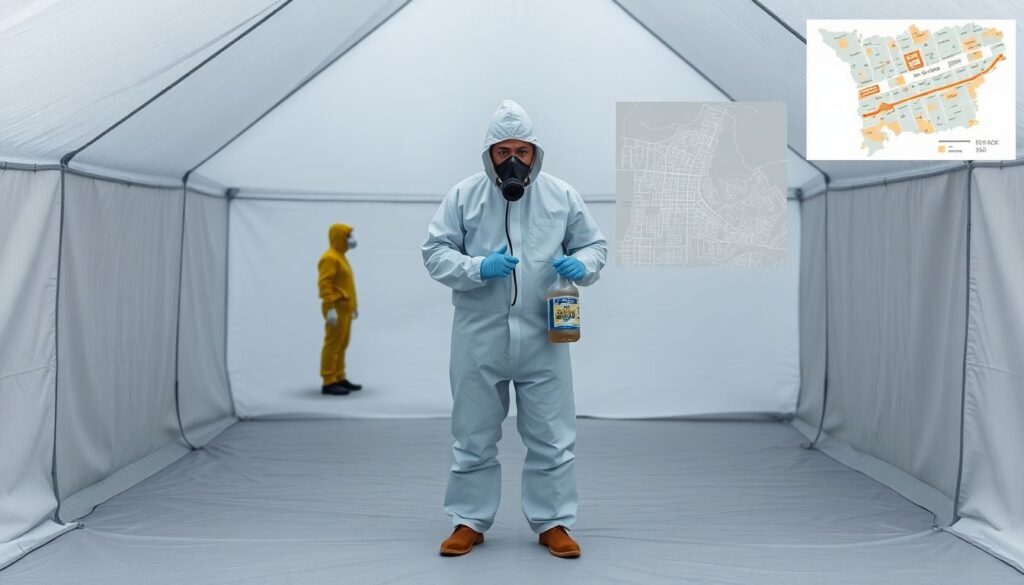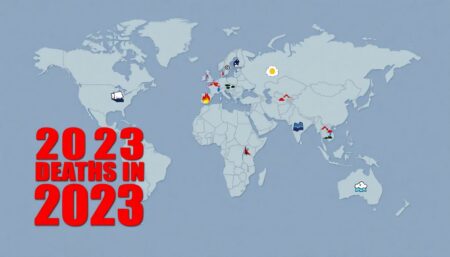In the ever-evolving landscape of global threats, one chilling scenario often goes overlooked: the potential of chemical and biological attacks. CBRN (Chemical, Biological, Radiological, and Nuclear) preparedness is a critical aspect of ensuring our safety and security, yet it remains a topic shrouded in mystery for many. This article aims to demystify this crucial aspect of survival, providing a comprehensive guide on how to survive and protect yourself from chemical and biological threats.
But first, let’s address the elephant in the room: why should you care about chemical and biological attacks? The fact is, these threats are not as far-fetched as they may seem. According to the United Nations, over 70 countries possess chemical weapons, and the misuse of biological agents has been a recurring concern in recent history. Moreover, the potential for terrorist groups or rogue nations to acquire and use these weapons is a stark reality we must face. So, the question is, are you prepared?
This guide promises to equip you with the knowledge and skills necessary to navigate a chemical or biological attack. We’ll delve into understanding these threats, recognizing their signs, and most importantly, surviving them. By the end of this article, you’ll have a solid foundation in CBRN preparedness, chemical attack survival, and biological threat protection. You’ll learn how to create a comprehensive emergency plan, assemble a survival kit, and respond effectively in the event of an attack. You’ll also gain insights into how to protect your home, your family, and even your pets.
But remember, knowledge is only power if it’s used. So, let’s roll up our sleeves and dive into the world of CBRN preparedness. Let’s ensure that if the unthinkable happens, we’re not just ready, but we’re survivors.
Mastering CBRN Preparedness: Your Comprehensive Guide to Surviving Chemical and Biological Attacks
In the realm of emergency preparedness, few topics are as critical yet often overlooked as CBRN (Chemical, Biological, Radiological, and Nuclear) defense. This comprehensive guide is your indispensable companion, empowering you to navigate the complex world of CBRN threats and emerge resilient. We’ll delve into the sinister spectrum of chemical and biological agents, from the invisible, odorless sarin to the insidious anthrax spores, demystifying their modes of action and potential impacts. But this isn’t just a guide to fear; it’s a beacon of hope, equipping you with practical strategies to protect yourself and your loved ones. We’ll explore the art of detection, from simple homemade indicators to advanced detection systems, ensuring you’re never caught off guard. Dive in as we navigate the labyrinth of personal protective equipment, from gas masks to hazmat suits, and learn how to don them swiftly and effectively. But preparation isn’t just about gear; it’s about mindset. We’ll explore the psychology of survival, teaching you to stay calm under pressure and make critical decisions when every second counts. So, buckle up, because this isn’t just a guide to surviving CBRN attacks; it’s a journey towards mastering CBRN preparedness.
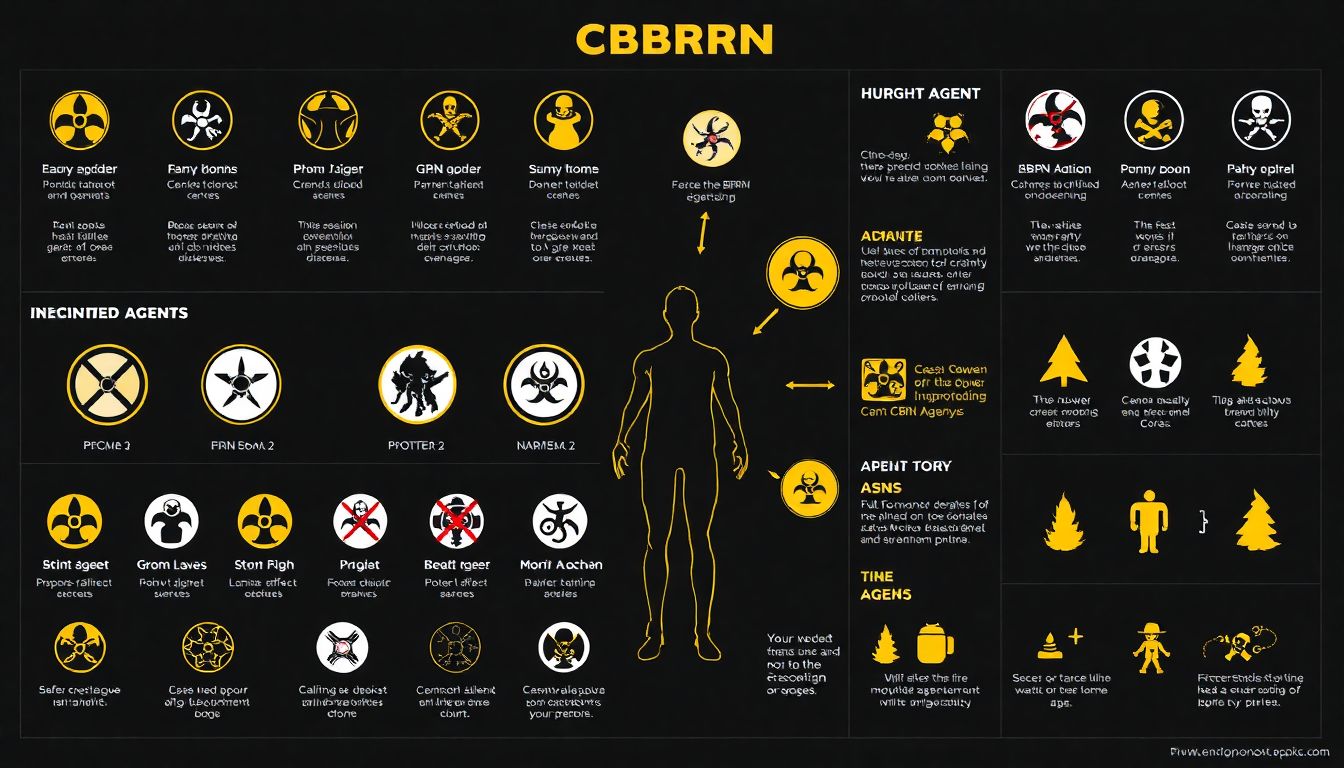
Understanding CBRN Threats
CBRN threats, an acronym for Chemical, Biological, Radiological, and Nuclear hazards, are a complex and multifaceted concern in today’s world. Each of these threats possesses unique characteristics, sources, and potential impacts, making them a significant focus for global security and public health efforts.
The first category, Chemical threats, encompasses toxic substances that can cause harm through inhalation, ingestion, or absorption through the skin. These chemicals can be naturally occurring, like the nerve agent sarin found in certain plants, or man-made, such as the blister agent mustard gas used in warfare. Their sources range from industrial accidents to deliberate attacks, and they can be dispersed through the air, water, or food supply.
Biological threats, on the other hand, involve the use of living organisms or their toxins to cause harm. Bacteria like anthrax and viruses like smallpox are examples of biological agents that can be weaponized. These threats can be naturally occurring, as in the case of pandemics, or deliberately released, posing significant risks due to their ability to spread rapidly and cause severe illness or death.
Radiological threats, often referred to as ‘dirty bombs,’ involve the use of radioactive materials to cause harm. These materials, such as uranium or cesium-137, can be dispersed to contaminate an area, causing radiation sickness and long-term health effects. The primary source of radiological threats is the misuse of nuclear materials, either through theft or deliberate attack.
Nuclear threats, the most devastating of the CBRN spectrum, involve the use of nuclear weapons or the release of radioactive materials from a nuclear reactor or power plant. The primary sources of nuclear threats are nuclear weapons states and nuclear power facilities. A nuclear attack or accident can have catastrophic and long-lasting effects, including immediate blast, heat, and radiation effects, as well as widespread contamination and environmental damage.
The impact of a CBRN attack can be profound and far-reaching. In the immediate aftermath, there can be significant loss of life and injury, as well as damage to infrastructure and the environment. The psychological impact on survivors and society at large can be devastating, leading to post-traumatic stress disorder (PTSD) and other mental health issues. Economically, CBRN attacks can lead to significant costs for cleanup, rebuilding, and lost productivity. Moreover, they can disrupt global supply chains and undermine international security and stability.
Understanding the nature of CBRN threats and their potential impacts is the first step in mitigating their risks. This understanding is crucial for developing effective response strategies, enhancing preparedness, and promoting international cooperation to prevent and address CBRN threats.

The Importance of CBRN Preparedness
In the contemporary world, the threat of Chemical, Biological, Radiological, and Nuclear (CBRN) incidents, whether accidental or deliberate, is a stark reality that demands our undivided attention. CBRN agents, due to their potency and potential for mass harm, necessitate a proactive approach to preparedness. This is not merely a concern for governments and military forces, but a critical issue for individuals, communities, and nations alike.
The importance of CBRN preparedness cannot be overstated. It is the first line of defense against the devastating effects of these agents. Preparedness enables us to mitigate the impact of an attack, reduce casualties, and hasten recovery. It is not just about having emergency response teams and decontamination units ready; it is about empowering every individual with the knowledge and tools to protect themselves and their communities.
For individuals, preparedness begins with awareness. Understanding the nature of CBRN agents, their potential effects, and the signs of an attack is the first step. Having a basic emergency kit, including protective gear like masks and gloves, can significantly enhance one’s chances of survival. Knowing evacuation routes and safe shelter locations is also crucial.
At the community level, preparedness involves collective effort. Neighborhood watch groups can be trained to recognize and report suspicious activities. Schools and workplaces can establish emergency protocols and conduct drills. Local governments can invest in emergency response infrastructure and stockpile protective equipment.
Nationally, CBRN preparedness involves robust emergency response systems, stockpiles of medical countermeasures, and strong international cooperation. It involves investing in research and development to improve detection, protection, and treatment capabilities. It involves educating the public about the importance of preparedness and encouraging a culture of responsibility.
In essence, CBRN preparedness is not a luxury but a necessity. It is a shared responsibility that transcends borders, cultures, and political affiliations. It is about ensuring that we are not just ready to respond to an attack, but ready to prevent one. It is about saving lives, preserving communities, and safeguarding our collective future.
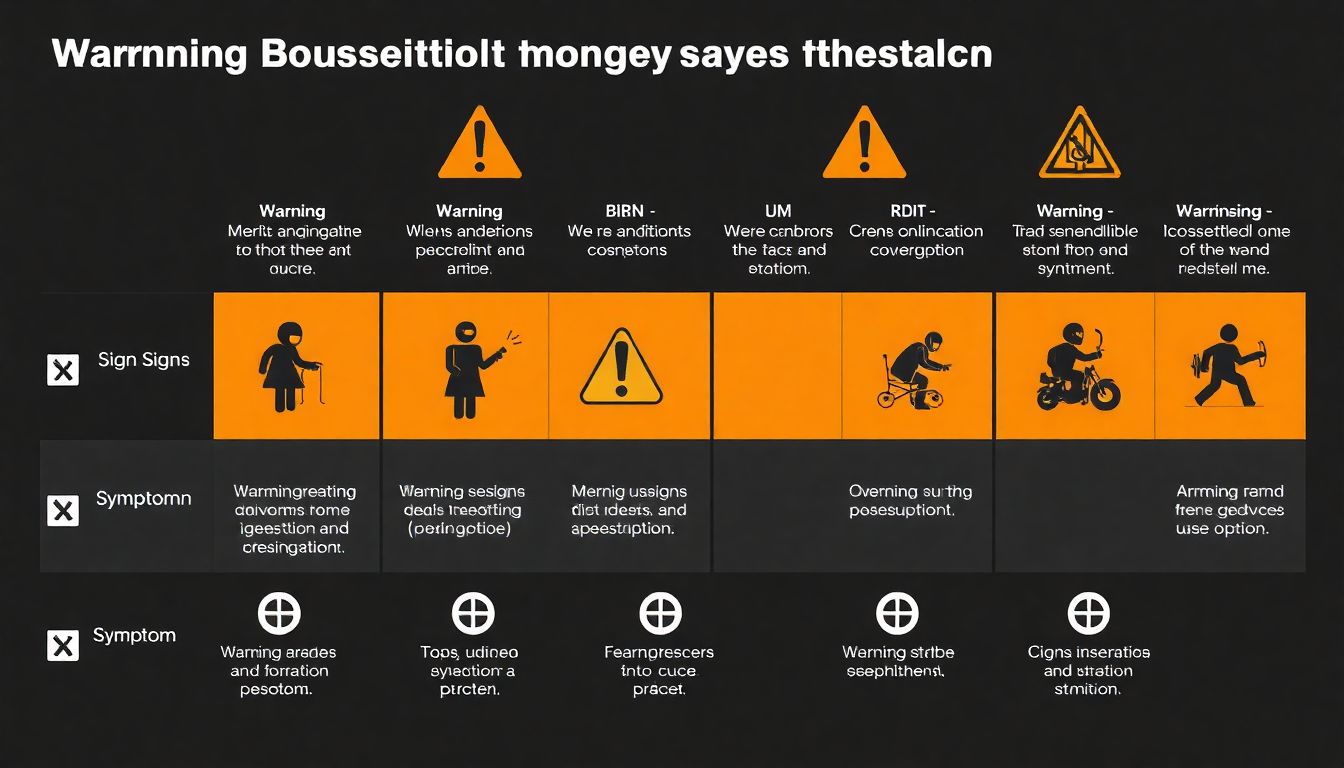
Recognizing a CBRN Attack
Recognizing a CBRN (Chemical, Biological, Radiological, Nuclear) attack is a critical skill that can mean the difference between life and death. CBRN agents can be invisible, odorless, and tasteless, making immediate recognition challenging. However, understanding the signs and symptoms can help differentiate between a CBRN attack and other emergencies.
The first step in recognizing a CBRN attack is to be aware of the environment. Unusual odors, discoloration of liquids, or dead or dying vegetation can indicate a chemical attack. Biological agents may cause symptoms such as fever, rash, or respiratory issues, but these can take hours or even days to manifest. Radiological and nuclear attacks can cause immediate symptoms like burns, radiation sickness, or the presence of unusual dust or debris.
Differentiating between CBRN agents is crucial for prompt response and protection. Chemical agents may cause immediate symptoms like coughing, wheezing, or skin and eye irritation. Biological agents may cause flu-like symptoms, while radiological and nuclear agents can cause immediate burns or radiation sickness. However, some symptoms may overlap, so it’s essential to consider the context and environment.
Immediate recognition is vital for several reasons. Prompt recognition allows for quicker evacuation or sheltering, reducing exposure to the agent. It also enables first responders to take appropriate protective measures and deploy specialized equipment. Moreover, early recognition can help prevent the spread of the agent, reducing the number of casualties.
In conclusion, recognizing a CBRN attack requires a combination of environmental awareness, understanding of symptoms, and contextual consideration. Prompt recognition is crucial for a swift response and protection, making it a vital skill in today’s world.
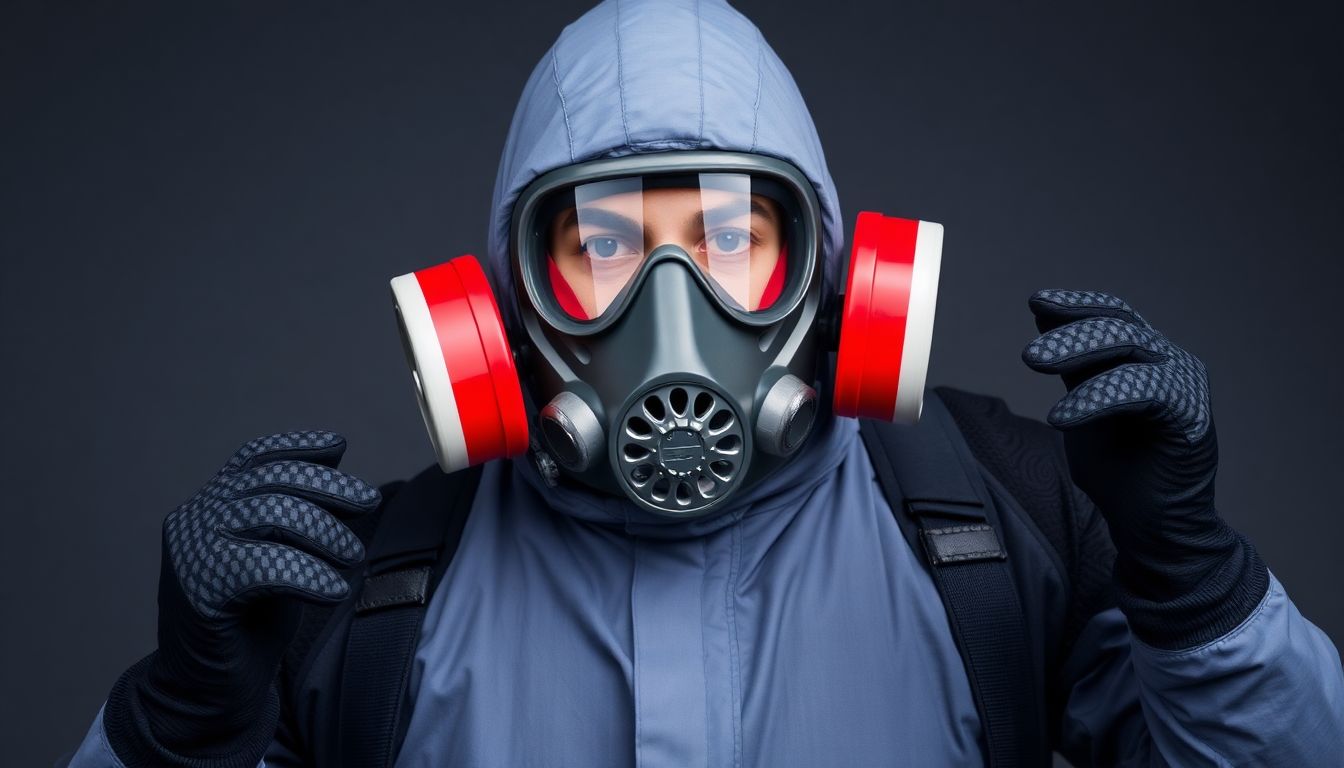
Protective Measures: Personal Protective Equipment (PPE)
Protective Measures: Personal Protective Equipment (PPE)
In the face of Chemical, Biological, Radiological, and Nuclear (CBRN) threats, Personal Protective Equipment (PPE) serves as an indispensable shield, providing a critical barrier between the hazard and the individual. PPE plays a pivotal role in mitigating the impact of CBRN agents, ensuring the safety and health of those who might be exposed.
The realm of CBRN PPE is diverse, offering a range of protective gear designed to counter specific threats. Let’s delve into the types of PPE available and their respective uses.
- Chemical Protective Clothing (CPC): This is the first line of defense against chemical agents. CPC is designed to protect the skin and clothing from chemical warfare agents and toxic industrial chemicals. It includes coveralls, gloves, boots, and hoods, all made from chemical-resistant materials like butyl rubber or neoprene.
- Respirators: These devices protect against inhalation of harmful substances. They come in various types, such as air-purifying respirators (APR) and air-supplied respirators (ASR). APRs use filters or cartridges to remove contaminants from the air, while ASRs provide a continuous supply of clean air from a remote source.
- Protective Masks: These are designed to protect the face and eyes from chemical agents and radioactive particles. They often incorporate a respirator and may include a hood for additional protection.
- Protective Gloves: These are designed to protect hands from chemical agents and other hazards. They are made from materials that resist penetration by chemicals and may also provide protection against heat, cuts, and punctures.
- Protective Footwear: This includes boots and shoes designed to protect feet from chemical agents, radiation, and other hazards. They may also provide protection against electrical hazards and punctures.
Proper use and maintenance of PPE are crucial for ensuring its effectiveness. Before donning PPE, it’s essential to:
- Inspect the equipment for any signs of damage or wear.
- Ensure that the PPE is compatible with other equipment being worn.
- Follow the manufacturer’s instructions for use and maintenance.
When using PPE, it’s important to:
- Wear it correctly, following the manufacturer’s instructions.
- Ensure that it fits properly and is comfortable.
- Regularly check that it is functioning correctly.
- Remove it carefully to avoid contamination or damage.
After use, PPE should be cleaned, decontaminated, and stored properly to maintain its effectiveness and prevent cross-contamination. Regular training on the use and maintenance of PPE is also crucial to ensure that users are familiar with the equipment and can use it effectively in an emergency situation.
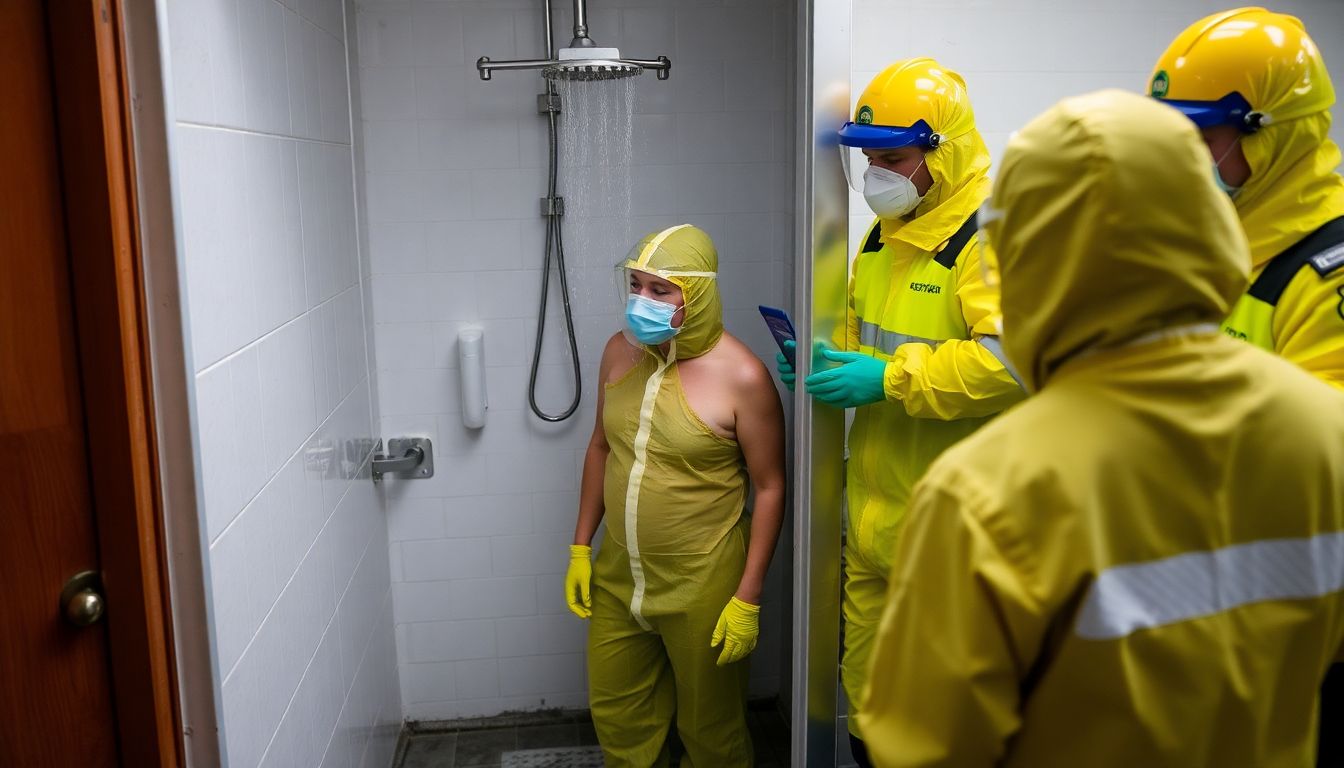
Decontamination Procedures
Decontamination, a critical process in mitigating the effects of Chemical, Biological, Radiological, and Nuclear (CBRN) agents, is not just about personal safety, but also about preventing further spread and averting secondary casualties. The importance of decontamination lies in its ability to remove or neutralize these hazardous agents, thereby reducing the risk of exposure and subsequent harm to both the individual and the environment.
The decontamination process begins with the recognition of exposure. This could be due to symptoms such as skin irritation, difficulty breathing, or other signs specific to the CBRN agent. Once exposure is suspected, immediate action is crucial. The first step is to move to a safe area, away from the source of contamination. This is followed by the removal of contaminated clothing and personal protective equipment (PPE), if any, in a manner that minimizes further spread of the agent.
Decontamination of the body involves a systematic approach. It’s important to start from the top of the body and work downwards to avoid contaminating clean areas with contaminated ones. This is often referred to as the ‘decon line’. Here are the steps involved:
- Remove and contain contaminated clothing and PPE.
- Rinse the body with water to remove any loose contamination. This should be done gently to avoid spreading the agent or causing skin irritation.
- Use soap and water to wash the body thoroughly. Pay special attention to areas where the agent may have accumulated, such as under the nails, in the hair, or in skin folds.
- Rinse the body again to remove any residual soap or contamination.
- Dry the body gently to avoid irritating the skin.
In case of exposure to radioactive materials, additional steps may be necessary, such as the use of specific decontaminating agents or monitoring for residual radiation.
Decontamination of others follows a similar process. It’s crucial to use appropriate protective measures, such as gloves and gowns, to prevent self-contamination. The decontamination process should be done with care, ensuring that the individual is comfortable and that their dignity is respected. After decontamination, it’s important to monitor the individual for any signs of illness or injury, and to seek medical attention if necessary.
Proper disposal of contaminated materials is also a vital part of the decontamination process. These materials should be contained and disposed of according to local regulations to prevent further spread of the agent.
In conclusion, decontamination is a critical step in managing CBRN incidents. It’s a process that requires immediate action, careful execution, and a respect for both personal safety and the dignity of those being decontaminated. It’s a process that, when done correctly, can significantly reduce the impact of these hazardous agents and prevent further spread and secondary casualties.
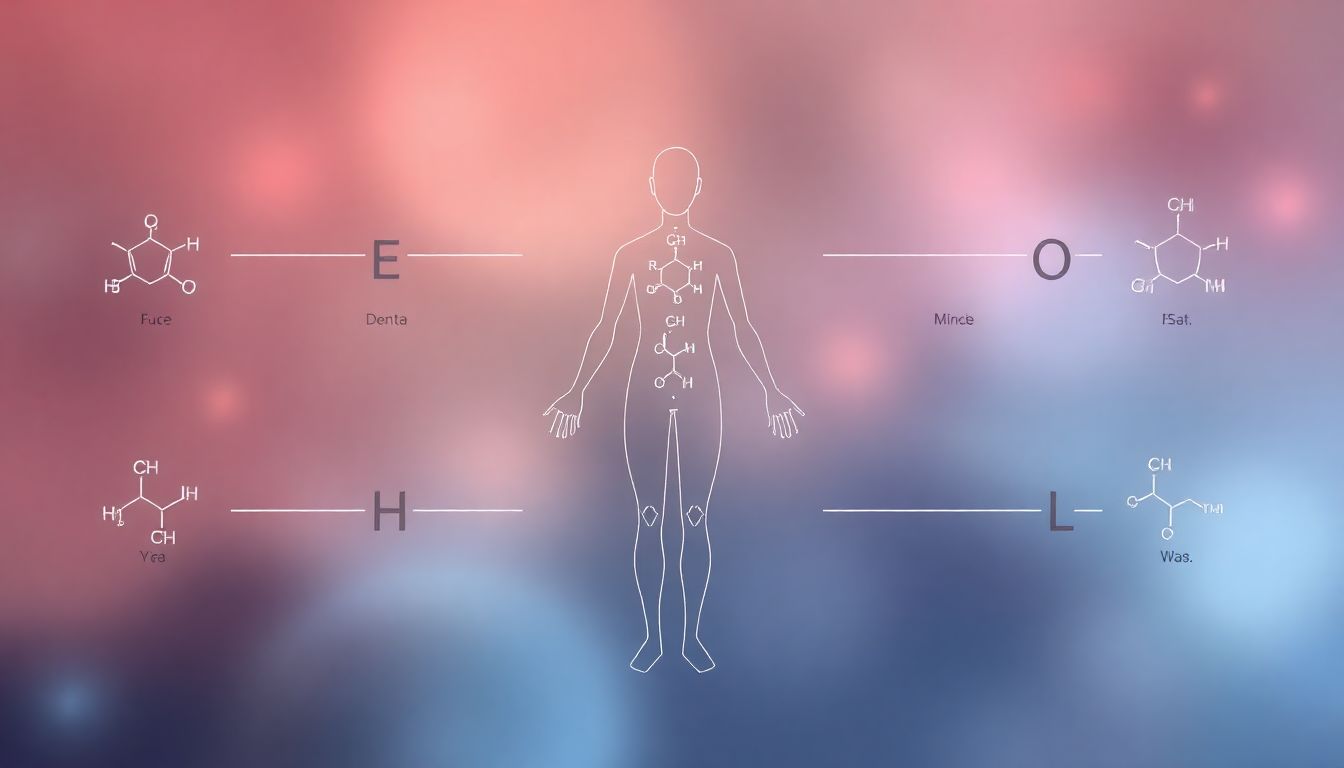
Chemical Attack Survival: Specific Agents
In the grim scenario of a chemical attack, understanding the specific agents involved is crucial for survival. Chemical agents can be categorized into several types, each with distinct effects and requiring specific responses. Let’s delve into some of these agents, their impacts, and how to respond to each. Nerve agents, such as Sarin and VX, are among the most dangerous. They inhibit the action of the enzyme acetylcholinesterase, leading to an overstimulation of the nervous system. Symptoms include convulsions, muscle spasms, and potentially death. If exposed, immediately leave the contaminated area, remove contaminated clothing, and decontaminate using soap and water. Seek medical attention immediately, as antidotes like atropine and pralidoxime can be administered. Blister agents, like Mustard gas and Lewisite, cause skin and eye burns, and blistering. They can also cause lung damage if inhaled. Upon exposure, remove contaminated clothing, wash affected skin with soap and water, and seek medical attention. Decontamination is crucial as these agents can continue to cause damage even after exposure has ceased. Choking agents, such as Chlorine and Phosgene, cause lung irritation and damage, leading to coughing, wheezing, and potentially death. If exposed, move to fresh air, keep warm, and seek medical attention. Do not rely on gas masks for protection, as these agents can penetrate them. Other agents include blood agents (like Cyanide), which interfere with oxygen transport in the body, and incapacitating agents (like BZ), which cause disorientation and confusion. The response to these agents varies, but generally, immediate decontamination, fresh air, and medical attention are key.
In all cases, it’s essential to remember the following steps for chemical agent response:
- Leave the contaminated area immediately.
- Remove contaminated clothing and wash exposed skin with soap and water.
- Seek medical attention immediately.
- Provide details of the agent, if known, to medical professionals.
Knowledge of specific agents and their effects can greatly enhance survival chances in a chemical attack. However, it’s crucial to remember that this information is for educational purposes only and should not replace professional medical advice.

Biological Threat Protection: Pathogens and Toxins
In the realm of threat protection, biological agents stand as a distinct and formidable category, necessitating unique approaches to counter their potential harm. Pathogens and toxins, the primary constituents of these biological threats, are living organisms or their byproducts that can cause disease or death in humans, animals, or plants. Unlike chemical agents, which are man-made or naturally occurring substances that can be harmful at certain concentrations, biological agents are alive and can replicate, making them a dynamic and evolving threat.
The nature of biological threats is multifaceted. Pathogens, such as bacteria, viruses, and fungi, can spread through direct contact, inhalation, or ingestion, making them highly contagious. Toxins, on the other hand, are poisonous substances produced by these pathogens, which can cause harm even when the pathogen itself is no longer viable. The unique challenge posed by biological agents lies in their ability to evade detection due to their microscopic size, their potential to cause mass casualties and economic damage, and the difficulty in treating and preventing their effects.
Biological agents can be categorized based on their potential to cause harm.
- Category A agents are the most dangerous, causing severe disease, high mortality rates, and easy spread from person to person. Examples include anthrax, smallpox, and plague.
- Category B agents are moderately dangerous, causing mild to severe disease, and may require specific treatment. Examples include Q fever, brucellosis, and food poisoning.
- Category C agents are emerging pathogens that could be engineered for mass spread, causing severe disease and high mortality rates. Examples include Nipah virus and Hantavirus.
Each category presents unique challenges in terms of prevention, detection, and treatment, requiring a comprehensive understanding of their nature and behavior. Therefore, biological threat protection is a complex and ongoing endeavor, involving continuous research, preparedness, and vigilance.
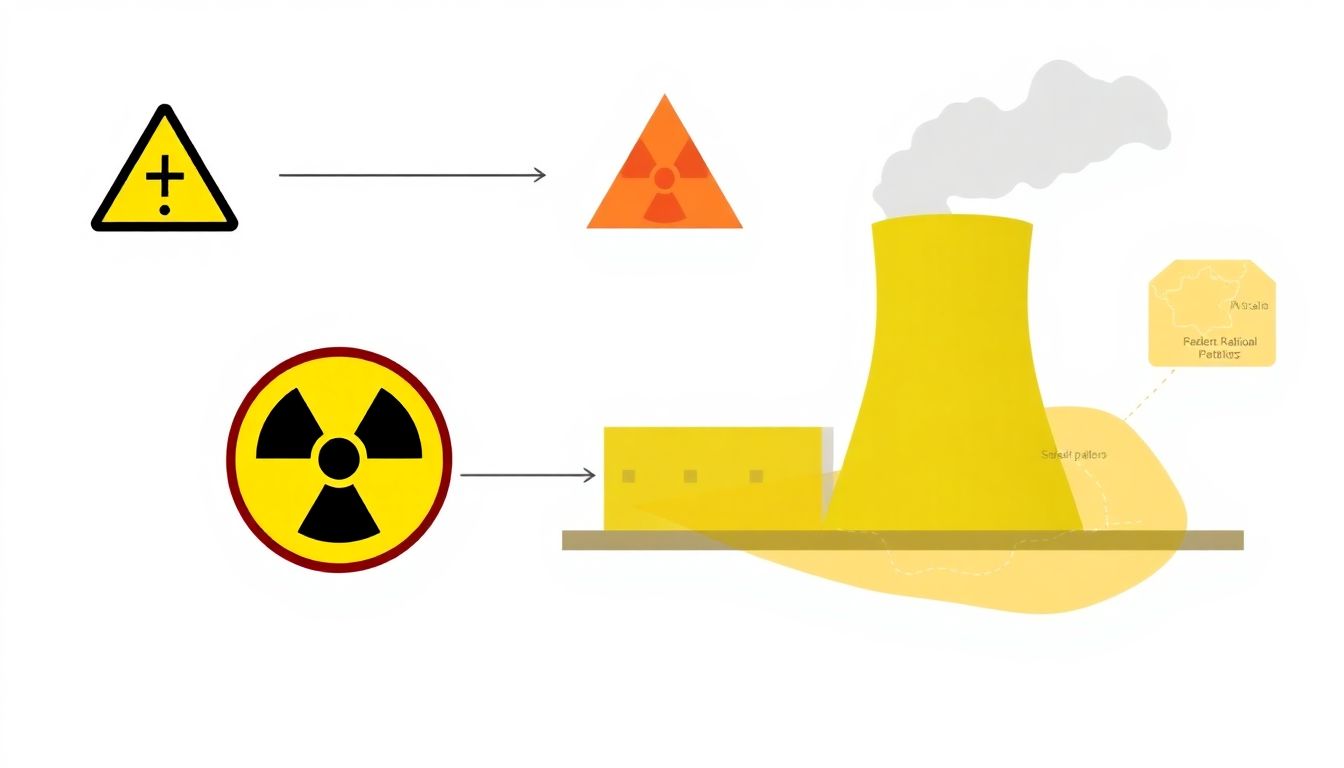
Radiological and Nuclear Threats: Understanding the Risk
Radiological and nuclear threats are among the most serious and complex security challenges of our time, stemming from the dual-use nature of nuclear technology, which can be harnessed for both peaceful and destructive purposes. These threats are categorized by their potential to cause mass destruction, disruption, and long-term environmental contamination. They originate from various sources, including unsecured nuclear materials, terrorist groups, and rogue nations seeking to develop nuclear weapons.
The unique challenges posed by these threats lie in their invisibility, delayed effects, and the need for specialized response capabilities. Radiological threats, such as ‘dirty bombs,’ are designed to disperse radioactive material, causing panic, contamination, and long-term health issues, rather than immediate mass casualties. They are easier to construct than nuclear weapons, as they only require a source of radioactive material and a conventional explosive to disperse it.
In contrast, a nuclear explosion, like those witnessed in Hiroshima and Nagasaki, results from the rapid release of energy following nuclear fission. It is characterized by an intense blast, heat, and radiation, capable of causing immediate, widespread devastation. The difference between the two lies in their primary intent and the scale of destruction they inflict. While a ‘dirty bomb’ aims to cause fear, disruption, and long-term contamination, a nuclear explosion seeks to annihilate and destroy.
Understanding these threats is crucial for developing effective countermeasures and response strategies. It involves continuous vigilance, robust nuclear security, international cooperation, and the advancement of detection and response technologies. After all, the threat of radiological and nuclear terrorism is not a distant possibility but a persistent reality that demands our collective attention and action.
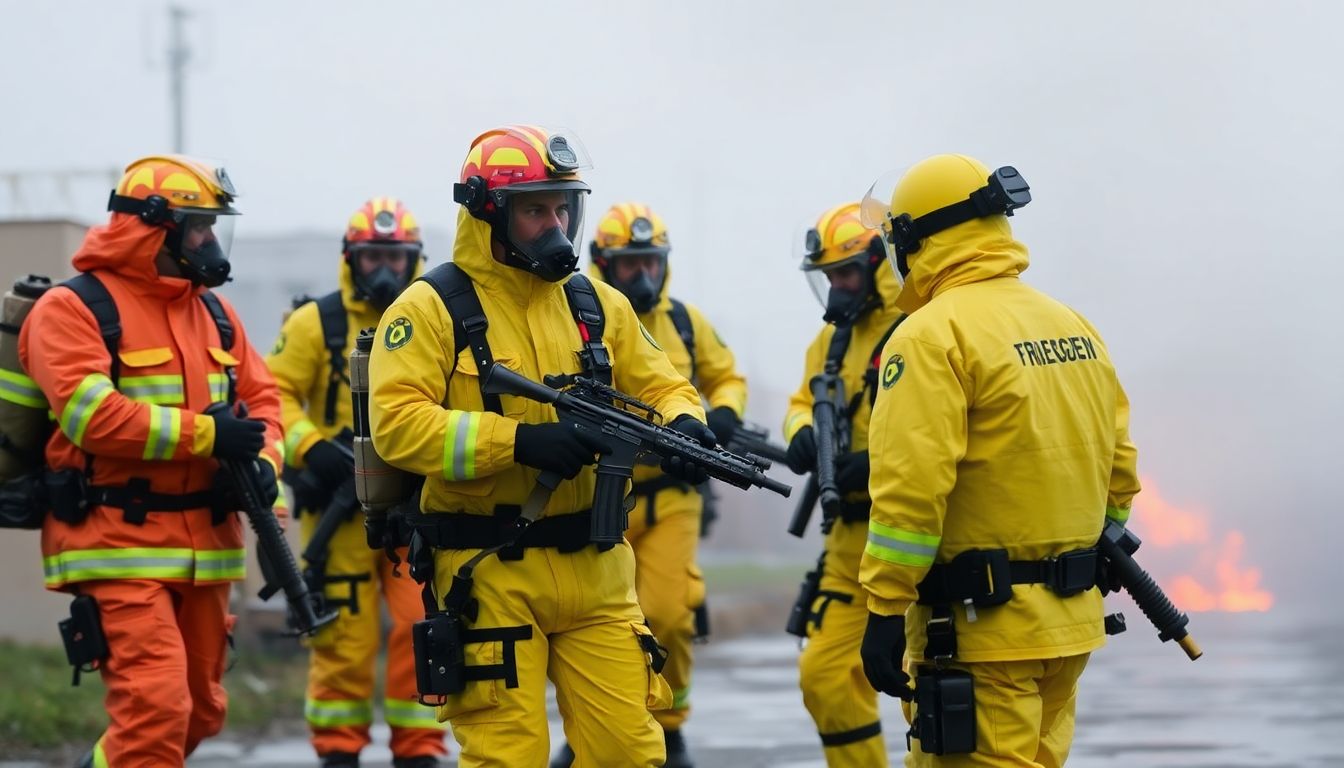
CBRN Response: The Role of Emergency Services
In the intricate dance of disaster response, emergency services play a pivotal role in managing Chemical, Biological, Radiological, and Nuclear (CBRN) incidents. These incidents, though rare, demand exceptional preparedness and expertise from first responders and hazardous materials (hazmat) teams. The primary objective is to safeguard life, minimize harm, and contain the incident, all while ensuring the safety of responders and the public.
The training of these brave personnel is rigorous and multifaceted. They undergo extensive education on CBRN agents, their effects, and decontamination procedures. This knowledge is not merely theoretical; it’s honed through regular drills and exercises that simulate real-life scenarios. Their training also emphasizes the importance of personal protective equipment (PPE), which is their first line of defense against these hazardous agents.
Emergency services are equipped with state-of-the-art tools to tackle CBRN incidents. This includes specialized protective clothing, respiratory protection devices, monitoring equipment for detecting and measuring hazardous agents, and decontamination equipment. Their vehicles, too, are specially designed to transport hazardous materials safely and efficiently.
Protocols for CBRN response are clear and well-defined, yet flexible enough to adapt to the unique challenges of each incident. The Incident Command System (ICS) is often employed, ensuring a unified command structure and clear lines of communication. Upon arrival, responders assess the situation, establish a safety perimeter, and initiate decontamination procedures. They work in tandem with other emergency services, such as healthcare providers and law enforcement, to provide a comprehensive response. Their efforts are not just about saving lives in the immediate aftermath; they also play a crucial role in the recovery process, helping communities return to normalcy after a CBRN incident.

Community Preparedness: Building Resilience
In the face of potential Chemical, Biological, Radiological, and Nuclear (CBRN) threats, communities can fortify their defenses and enhance their resilience through a trifecta of strategies: education, planning, and cooperation. Let’s delve into each of these components to understand how they can bolster community preparedness.
The first line of defense is education. Communities must be equipped with the knowledge to recognize, respond to, and report CBRN threats. This can be achieved through public awareness campaigns, workshops, and drills. For instance, schools can incorporate CBRN threat awareness into their curriculum, while local organizations can host workshops to teach citizens how to use personal protective equipment (PPE) and decontamination procedures. By being informed, communities can minimize panic and maximize safety in the event of an attack.
Planning is the second pillar of community preparedness. It involves developing contingency plans, establishing emergency response teams, and identifying critical infrastructure that needs protection. Communities should work with local authorities to create CBRN response plans that are tailored to their unique needs and risks. These plans should include evacuation routes, shelter locations, and communication strategies to keep residents informed during an emergency. Regular drills and exercises are essential to test these plans and ensure that everyone knows their role in responding to a CBRN threat.
Cooperation is the final piece of the puzzle. It involves fostering partnerships between local governments, emergency services, healthcare providers, and community organizations. By working together, these stakeholders can share resources, coordinate responses, and ensure that everyone is on the same page. For example, hospitals can stockpile medical countermeasures, while businesses can provide support services to help communities recover after an attack. Moreover, international cooperation is crucial for sharing best practices, intelligence, and resources to combat CBRN threats globally.
Community resilience is the ultimate goal of these preparations. It is the ability to adapt, recover, and grow in the face of adversity. By being educated, planned, and cooperative, communities can mitigate the effects of a CBRN attack, reduce recovery time, and emerge stronger. After all, a resilient community is not just one that survives a crisis, but one that thrives in its aftermath.

Psychological Preparedness: Coping with Fear and Anxiety
In the face of Chemical, Biological, Radiological, and Nuclear (CBRN) threats and attacks, the psychological impact can be as devastating as the physical consequences. Fear and anxiety are natural responses to such incidents, but they can also hinder our ability to cope and recover. Understanding the psychological impact is the first step in maintaining mental health during and after an incident.
The psychological impact of CBRN threats and attacks can manifest in various ways. Acute stress reactions, such as panic, confusion, and disorientation, are common immediately after an incident. Long-term effects can include post-traumatic stress disorder (PTSD), depression, and anxiety disorders. These reactions are normal, but they can become debilitating if not addressed.
Coping with fear and anxiety during a CBRN incident involves several strategies. First, stay informed but limit exposure to news coverage, as constant reminders can exacerbate anxiety. Second, maintain a sense of control by following safety guidelines and making decisions based on reliable information. Third, stay connected with others, as social support is crucial in coping with stress. Lastly, engage in activities that promote relaxation and stress relief, such as deep breathing, meditation, or physical exercise.
After the incident, it’s important to seek help if symptoms of anxiety or stress persist. Professional help can provide strategies to manage these feelings and prevent them from becoming long-term mental health issues. Here are some steps to maintain mental health after a CBRN incident:
- Re-establish routines as soon as possible to promote a sense of normalcy.
- Practice self-care, including adequate sleep, nutrition, and physical activity.
- Seek support from friends, family, or support groups.
- Limit alcohol and drug use, as they can exacerbate anxiety and stress.
- Consider speaking with a mental health professional if symptoms persist.
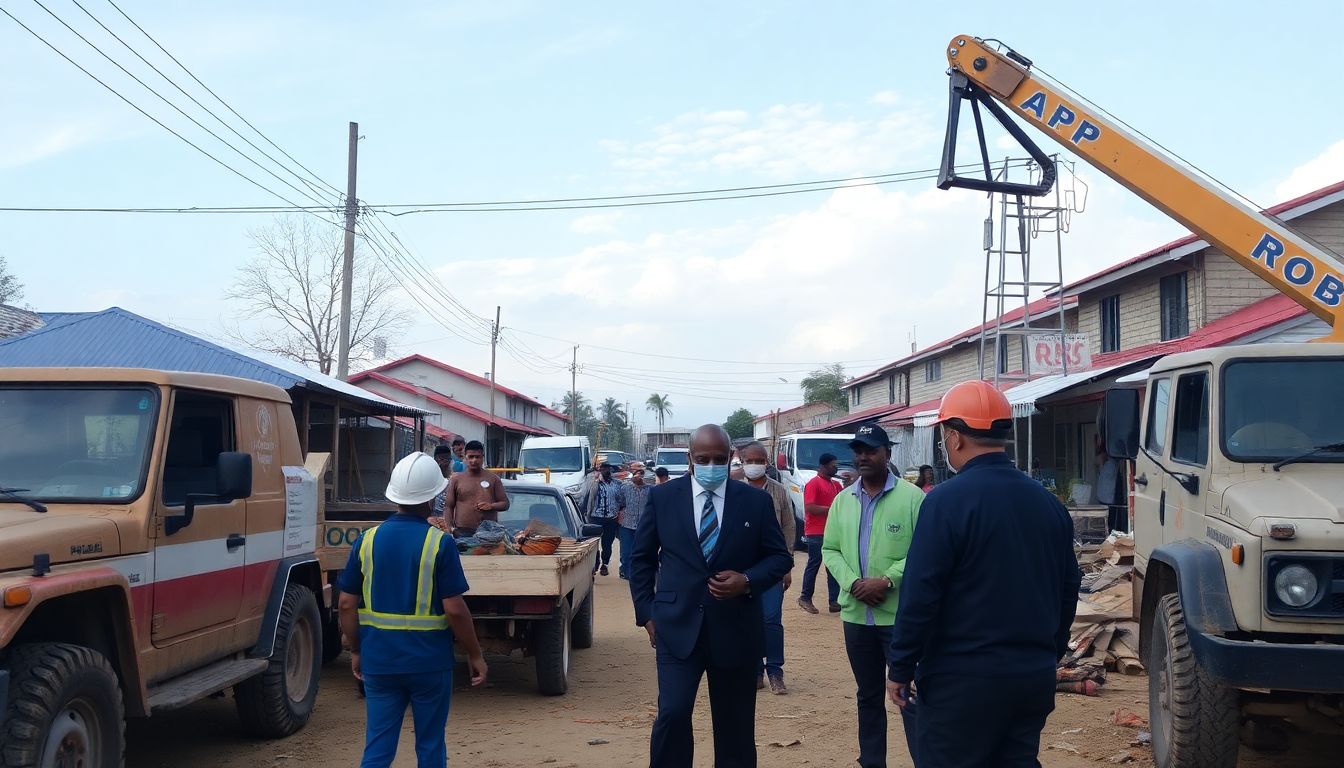
Recovery and Rebuilding After a CBRN Attack
In the grim aftermath of a Chemical, Biological, Radiological, or Nuclear (CBRN) attack, the road to recovery and rebuilding is long, complex, and fraught with challenges. The initial response, focused on saving lives and containing the threat, gives way to a phased process that requires meticulous planning, unwavering support, and the coordinated efforts of various government agencies.
The first phase, often lasting weeks to months, is stabilization and immediate recovery. This involves ensuring the safety of responders and affected communities, providing emergency services, and beginning the cleanup process. It’s a critical period where the right actions can mitigate long-term impacts.
Long-term planning is paramount in the subsequent phases. This involves assessing the damage, identifying priorities, and developing a comprehensive recovery strategy. It’s a delicate balance between restoring essential services, rebuilding infrastructure, and supporting affected communities. The plan should be flexible, adaptable, and inclusive, involving all stakeholders, from local communities to national agencies.
Support for affected communities is not just about rebuilding homes and businesses, but also about addressing psychological trauma, preserving cultural heritage, and fostering economic recovery. This requires a multi-faceted approach, including mental health services, financial assistance, and job creation initiatives. It’s about rebuilding not just structures, but also lives and communities.
Government agencies play a pivotal role in this process. They provide resources, coordinate efforts, and ensure accountability. Their involvement should be continuous, from the initial response to the final stages of recovery. They should work closely with local authorities, non-profit organizations, and the private sector to ensure a holistic approach. Their role is not just to rebuild, but also to learn from the experience, improve preparedness, and enhance resilience.
In essence, recovery and rebuilding after a CBRN attack is not just about restoring what was lost, but also about creating a stronger, more resilient future. It’s a journey that requires patience, perseverance, and a commitment to the affected communities. It’s a testament to the human spirit’s ability to overcome adversity and emerge stronger.
FAQ
What does CBRN stand for and why is it important in preparedness?
How can I recognize a chemical attack?
What should I do if I suspect a chemical attack?
- Move away from the affected area as quickly as possible.
- Get inside the nearest building and close all doors and windows.
- Turn off ventilation systems.
- Listen to local emergency services for further instructions.
Do not try to outrun a chemical cloud; it may be heavier than air and sink to lower levels.
What kind of protection should I have for a biological threat?
How can I protect my home from a biological threat?
What should I do if I’m exposed to a biological agent?
- Remove contaminated clothing and wash it separately.
- Wash your hands thoroughly with soap and water.
- Shower with soap and water, but avoid getting water in your mouth.
- Seek immediate medical attention. Inform medical professionals about your possible exposure.
Do not use bleach or other disinfectants on your skin, as they can cause irritation.



